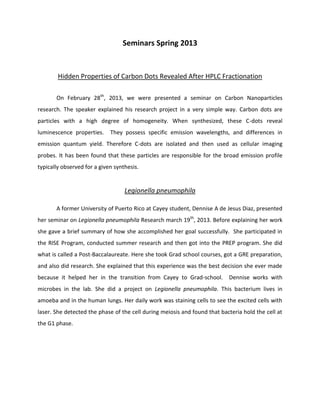Seminars spring 2013
- 1. Seminars Spring 2013 Hidden Properties of Carbon Dots Revealed After HPLC Fractionation On February 28th , 2013, we were presented a seminar on Carbon Nanoparticles research. The speaker explained his research project in a very simple way. Carbon dots are particles with a high degree of homogeneity. When synthesized, these C-dots reveal luminescence properties. They possess specific emission wavelengths, and differences in emission quantum yield. Therefore C-dots are isolated and then used as cellular imaging probes. It has been found that these particles are responsible for the broad emission profile typically observed for a given synthesis. Legionella pneumophila A former University of Puerto Rico at Cayey student, Dennise A de Jesus Diaz, presented her seminar on Legionella pneumophila Research march 19th , 2013. Before explaining her work she gave a brief summary of how she accomplished her goal successfully. She participated in the RISE Program, conducted summer research and then got into the PREP program. She did what is called a Post-Baccalaureate. Here she took Grad school courses, got a GRE preparation, and also did research. She explained that this experience was the best decision she ever made because it helped her in the transition from Cayey to Grad-school. Dennise works with microbes in the lab. She did a project on Legionella pneumophila. This bacterium lives in amoeba and in the human lungs. Her daily work was staining cells to see the excited cells with laser. She detected the phase of the cell during meiosis and found that bacteria hold the cell at the G1 phase.
- 2. Schizophrenia Research April 4th , 2013, José Peña gave a seminar presenting his research on a disease called Schizophrenia. People with Schizophrenia experience delusions, hallucinations, lack of motivation, alterations in the memory and executive functioning. This affects 1% of the population. Schizophrenia is caused by various disorders on the brain, and developmental disruption. He explained his work in the lab with mice. He decapitates them and uses the brain to see what goes on in the brain of a schizophrenic mouse. This is where disbinding and schizophrenia gene alteration is done with cannabis abuse. He also works on treatment, controlling the patient and its effects.


